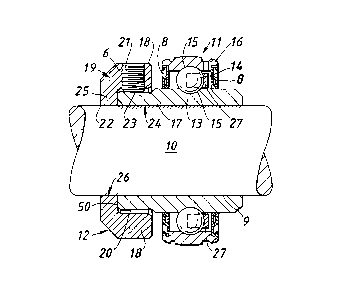Some of the information on this Web page has been provided by external sources. The Government of Canada is not responsible for the accuracy, reliability or currency of the information supplied by external sources. Users wishing to rely upon this information should consult directly with the source of the information. Content provided by external sources is not subject to official languages, privacy and accessibility requirements.
Any discrepancies in the text and image of the Claims and Abstract are due to differing posting times. Text of the Claims and Abstract are posted:
| (12) Patent: | (11) CA 2170386 |
|---|---|
| (54) English Title: | LOCKING DEVICE FOR USE WITH SHAFTS OR TUBES |
| (54) French Title: | DISPOSITIF DE VERROUILLAGE DESTINE A DES ARBRES OU DES TUBES |
| Status: | Term Expired - Post Grant Beyond Limit |
| (51) International Patent Classification (IPC): |
|
|---|---|
| (72) Inventors : |
|
| (73) Owners : |
|
| (71) Applicants : |
|
| (74) Agent: | OYEN WIGGS GREEN & MUTALA LLP |
| (74) Associate agent: | |
| (45) Issued: | 1999-04-27 |
| (86) PCT Filing Date: | 1994-09-26 |
| (87) Open to Public Inspection: | 1995-04-06 |
| Examination requested: | 1996-02-26 |
| Availability of licence: | N/A |
| Dedicated to the Public: | N/A |
| (25) Language of filing: | English |
| Patent Cooperation Treaty (PCT): | Yes |
|---|---|
| (86) PCT Filing Number: | PCT/GB1994/002090 |
| (87) International Publication Number: | WO 1995009310 |
| (85) National Entry: | 1996-02-26 |
| (30) Application Priority Data: | ||||||
|---|---|---|---|---|---|---|
|
A locking device for clamping onto a shaft is
composed of a collar and a ring fitted onto the shaft. The
collar has an end wall and an axial region extending over an
outer inclined contact surface of the ring. The ring and
the collar end wall have inner contact surfaces confronting
the outer surface of the shaft which are separated by
sliding radial surfaces of the collar and the ring. Screw-
threaded elements set in threaded bores in the axial region
of the collar can be tightened against the outer contact
surface of the ring to cause the inner contact surfaces to
exert clamping force on the shaft.
Un dispositif de verrouillage, destiné à être serré sur un arbre (10), est composé d'un collier (19) et d'une bague (13, 17) s'adaptant à l'arbre (10). Le collier (19) comprend une paroi terminale (25) ainsi qu'une région axiale (18) s'étendant sur une surface de contact inclinée (20) de la bague (13, 17). Cette dernière (13, 17), ainsi que la paroi terminale (25) du collier présentent des surfaces de contact internes (9, 22), opposées à la surface externe de l'arbre (10), qui sont séparées par des surfaces radiales coulissantes (50) du collier (19) et de la bague (13, 17). Des éléments filetés (21), ménagés dans des trous filetés (6) dans la région axiale (18) du collier (19), peuvent être resserés contre la surface de contact externe (20) de la bague (13, 17) afin que leurs surfaces de contact internes (9, 22) exercent une force de serrage sur l'arbre (10).
Note: Claims are shown in the official language in which they were submitted.
Note: Descriptions are shown in the official language in which they were submitted.

2024-08-01:As part of the Next Generation Patents (NGP) transition, the Canadian Patents Database (CPD) now contains a more detailed Event History, which replicates the Event Log of our new back-office solution.
Please note that "Inactive:" events refers to events no longer in use in our new back-office solution.
For a clearer understanding of the status of the application/patent presented on this page, the site Disclaimer , as well as the definitions for Patent , Event History , Maintenance Fee and Payment History should be consulted.
| Description | Date |
|---|---|
| Inactive: Expired (new Act pat) | 2014-09-26 |
| Appointment of Agent Requirements Determined Compliant | 2010-11-02 |
| Inactive: Office letter | 2010-11-02 |
| Inactive: Office letter | 2010-11-02 |
| Revocation of Agent Requirements Determined Compliant | 2010-11-02 |
| Letter Sent | 2010-10-28 |
| Letter Sent | 2010-10-28 |
| Revocation of Agent Request | 2010-09-29 |
| Appointment of Agent Request | 2010-09-29 |
| Inactive: Single transfer | 2010-09-29 |
| Letter Sent | 2007-11-21 |
| Inactive: Office letter | 2007-10-17 |
| Inactive: IPC from MCD | 2006-03-12 |
| Inactive: IPC from MCD | 2006-03-12 |
| Grant by Issuance | 1999-04-27 |
| Pre-grant | 1999-01-14 |
| Inactive: Final fee received | 1999-01-14 |
| Notice of Allowance is Issued | 1998-07-29 |
| Letter Sent | 1998-07-29 |
| Notice of Allowance is Issued | 1998-07-29 |
| Inactive: Application prosecuted on TS as of Log entry date | 1998-07-23 |
| Inactive: Status info is complete as of Log entry date | 1998-07-23 |
| Inactive: Approved for allowance (AFA) | 1998-06-02 |
| All Requirements for Examination Determined Compliant | 1996-02-26 |
| Request for Examination Requirements Determined Compliant | 1996-02-26 |
| Application Published (Open to Public Inspection) | 1995-04-06 |
There is no abandonment history.
The last payment was received on 1998-08-06
Note : If the full payment has not been received on or before the date indicated, a further fee may be required which may be one of the following
Please refer to the CIPO Patent Fees web page to see all current fee amounts.
Note: Records showing the ownership history in alphabetical order.
| Current Owners on Record |
|---|
| NSK EUROPE LTD |
| Past Owners on Record |
|---|
| GEORGE SWINLEY |